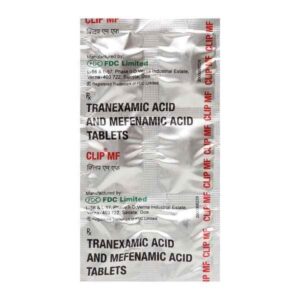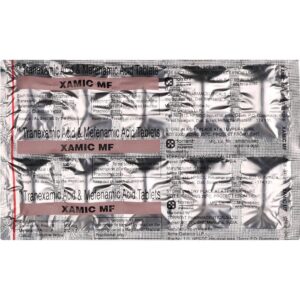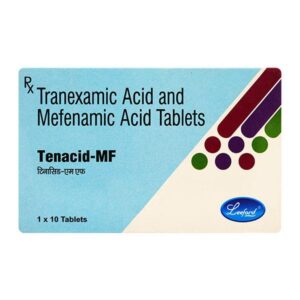TRANEXAMIC ACID + MEFENAMIC ACID
Tranexamic Acid: Tranexamic Acid is a medication used to prevent or treat excessive bleeding, particularly for conditions like heavy menstrual bleeding, nosebleeds, and bleeding in the urinary tract. It can also be used in situations where surgery or dental procedures may cause heavy bleeding, or as an emergency treatment for severe bleeding after childbirth.
The mechanism of action of Tranexamic Acid involves its ability to prevent the breakdown of blood clots. It works by inhibiting the activity of plasmin, an enzyme that dissolves blood clots. By blocking the action of plasmin, Tranexamic Acid helps to stabilize the clot and reduce bleeding.
The dose of Tranexamic Acid depends on the condition being treated. For heavy menstrual bleeding, the usual recommended dose is 1 gram three times a day for a maximum of 5 days, starting on the day bleeding begins. For nosebleeds, a lower dose of 500 milligrams to 1 gram three times a day may be used. In cases of severe bleeding or for surgical procedures, higher doses may be required.
Like any medication, Tranexamic Acid may cause side effects. Common side effects include gastrointestinal disturbances such as nausea, diarrhea, and stomach cramps. Less commonly, it can cause dizziness, headache, nasal congestion, and muscle pain. Rarely, allergic reactions may occur, presenting as a rash, itching, or swelling.
It is important to note that Tranexamic Acid should not be used by individuals with a history of blood clots or certain eye conditions. It may also interact with other medications, so it is important to inform healthcare professionals of all current medications and medical conditions before starting treatment.
Overall, Tranexamic Acid is a useful medication for controlling bleeding in various situations. However, it should only be used under the guidance of a healthcare professional, who will assess the risks and benefits based on the individual’s specific condition.
Mefenamic Acid: Mefenamic Acid is a nonsteroidal anti-inflammatory drug (NSAID) that is commonly used for the treatment of pain and inflammation associated with various conditions such as menstrual cramps, migraine headaches, and rheumatoid arthritis.
The mechanism of action of Mefenamic Acid involves inhibition of the enzymes cyclooxygenase-1 and cyclooxygenase-2. These enzymes play a key role in the production of prostaglandins, which are chemicals responsible for pain, inflammation, and fever. By inhibiting these enzymes, Mefenamic Acid reduces the production of prostaglandins, thus providing pain relief and reducing inflammation.
The recommended dose of Mefenamic Acid may vary depending on the condition being treated. For menstrual pain, the usual starting dose is 500 mg followed by 250 mg every 6 hours as needed, not exceeding a total daily dose of 1,500 mg. For other conditions, the initial dose is usually 500 mg followed by 250 mg every 6 hours as needed, not exceeding a total daily dose of 1,000 mg.
As with any medication, Mefenamic Acid can cause side effects. Common side effects may include nausea, abdominal pain, gastrointestinal upset, diarrhea, and dizziness. These side effects are usually mild and transient in nature. However, more serious side effects such as gastrointestinal bleeding, ulcers, kidney problems, and allergic reactions can occur, although they are less common and require immediate medical attention.
It is important to note that Mefenamic Acid should not be used in individuals with a history of asthma, bleeding disorders, gastrointestinal ulcers, kidney disease, or those who are allergic to NSAIDs. It may also interact with other medications, so it is essential to inform your healthcare provider about all the medications you are taking.
Overall, Mefenamic Acid is an effective medication for the treatment of pain and inflammation, but it should be used with caution and under medical supervision due to its potential side effects.





